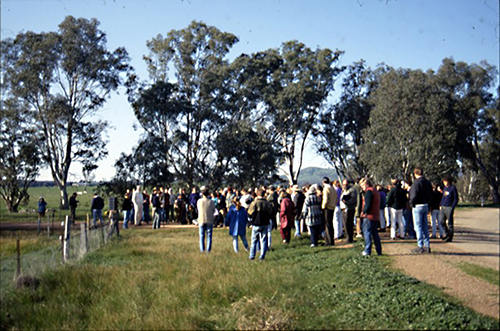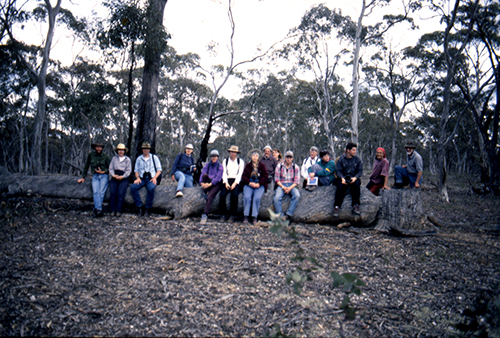PARK WATCH Article June 2023 |
Twenty years on, Charlie Sherwin reflects on the long campaign to protect Victoria’s Box-Ironbark forests
Sitting quietly in the twilight dew with a small group of good people, I recalled my mentor’s words: ‘Don’t over-promise when you take punters in the bush: the wildlife won’t cooperate’. So, hoping for a miracle, we fixed our eyes on an old, haggard tree our guides had led us to.
There! With the nervy excitement of one who may be predator or prey, a Phascogale emerged from a hollow in the trunk, fluffy tail quivering, and spiralled up towards the canopy. One at a time, another Phascogale and two Squirrel Gliders followed, bringing the woodland to life. We had under-promised, but the old Grey Box had delivered an inspirational night for us.
In for the long haul
We often had to manage each other’s expectations over the decade that it took to get better protection for the few big old trees and wildflower-strewn woodlands that remained in the Box-Ironbark country.
We’d begun to craft a plan to lift the fortunes of this fragmented ecosystem (83 per cent of it was destroyed, and the rest was still getting hammered) when the Kennett Liberal/National Government came to power in October 1992. Their policy platform wasn’t environment-friendly, so we found ourselves sitting on the balcony of the VNPA office in Parliament Place wondering whether to just give up.
Instead, we resolved that even if it took a decade of campaigning, and only achieved protection of 1000 hectares of this tragic, beautiful place, it would be worth it.
We persevered: working with farmers to create corridors linking together remnants of Box-Ironbark Woodlands; fighting alongside local residents to stop open-cut mines among the Ironbarks; highlighting systematic breaches of timber cutting guidelines; and teaming up with field naturalists to showcase this wonderful mix of forests and woodlands dominated by Ironbarks and Box Eucalypts (including through our 1994 publication The Forgotten Forests).
More and more brave, gentle, passionate and persistent people from across north-central and north-eastern Victoria, as well as VNPA staff, volunteers and members in Melbourne, came together to champion this busted bit of bush.

Rallying the community
A joint VNPA/Field Naturalists Club of Victoria conference held in Benalla in 1995 gave a strong boost to public awareness and scientific interest in the ecosystem. With the advent of ‘brick’ mobile phones we were able to keep the local media up to date with campaign activities as they happened.
The people were as wonderful as the plants and animals: field naturalists who knew every orchid in their patch; farmers who gave their hearts, their sweat and more to help these woodlands; botanists, zoologists, journalists, amazing public servants, some good-hearted politicians, and VNPA members, donors and supporters all gave great support to the campaign.
It’s not surprising that people were so passionate about this bush. In one small remnant near Stawell there are more species of terrestrial orchids than in all of Europe and North America combined. The Chiltern forest alone has over 220 bird species. And no spectacle is livelier than a Phascogale in terminal breeding frenzy!
The head of the Land Conservation Council (LCC) met with us in 1995 at our behest to discuss the merits of a Box-Ironbark investigation. A year or so later the Kennett Government commissioned the LCC to review public land use in the Box-Ironbark country, and a major milestone of our campaign was reached.
That same year, the government tried to push through national park status for Chiltern forest while deleting its very name. They proposed calling it the ‘Box-Ironbark National Park’ but this went down like a lead balloon in the region. It pre-empted the LCC’s review and the community consultation, took away the Chiltern community’s sense of identity and heritage and, worst of all, it tacitly suggested that there would be only one new reserve in the ecosystem, hinting that nature-lovers from Wangaratta to St Arnaud may miss out. A vehement local backlash killed the proposal.
Another apparent setback came a year later in 1997, with the LCC’s abolition. Under the gaze of VNPA’s campaign, however, the government allowed the new Environment Conservation Council (ECC) to carry on the Box-Ironbark work in good faith.
Public submissions throughout the five-year ECC investigation came predominantly from the Box-Ironbark region and overwhelmingly favoured greater protection in parks. This was a strong indication to wavering politicians that the region’s community loved their bush: that looking after ‘fluffy animals and trees’ in the Box-Ironbark country was in keeping with looking after their constituents.
Some of those submissions were pretty powerful. I recall one that contained the childhood memory of a boy looking up as his father swung an axe at a big ‘chimneyed’ red Ironbark whose hollowed trunk had filled with resin-stained rainwater. The child never forgot the gush of red as the axe cut into that great old tree.

Eventual success
Through VNPA’s campaign, all the trees, wildflowers, birds, animals and the people who cherished them became visible to people well beyond the region itself.
Although we were right in thinking the campaign may take ten years, we were wrong about achieving only 1000 hectares of reserves. In October 2002, ten years after we sat on that balcony in Parliament Place, the Bracks Labor Government created over 100 times that area of new Box-Ironbark parks and reserves. Fittingly, Jason Doyle who had come from the Goulburn Valley Environment Group in 1999 to lead VNPA’s campaign, was sitting in the Parliamentary Gallery to see the new parks enshrined in law.
VNPA staff and supporters provided the initial vision for this achievement, but it was Box-Ironbark people with grass seeds in their socks and their eyes swinging between the tree canopy and the dappled woodland floor, who bought it home for all of us.
The success of the Box-Ironbark campaign heralded an increase in woodland conservation over the ensuing 20 years, beyond Victoria to other woodlands across Australia’s inland slopes and plains, and up into the great tropical savannahs of northern Australia. All inspired by four fluffy animals and an old Grey Box.
Victoria’s Box-Ironbark national parks are Chiltern-Mt Pilot, Warby-Ovens, Heathcote-Graytown, Greater Bendigo, Kara Kara and Castlemaine Diggings National Heritage Park, along with many important smaller reserves.
- Read the latest full edition of Park Watch magazine
- Subscribe to keep up-to-date about this and other nature issues in Victoria
- Become a member to receive Park Watch magazine in print
